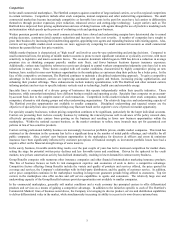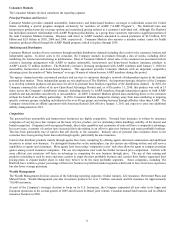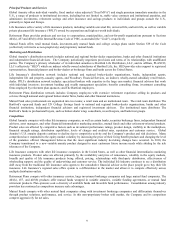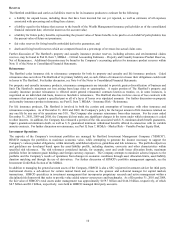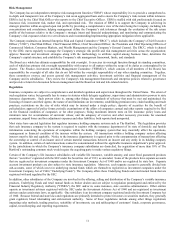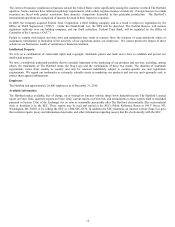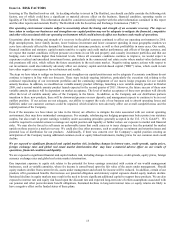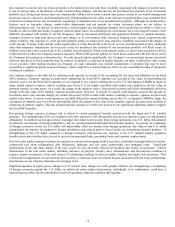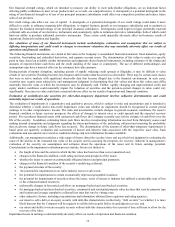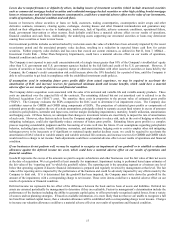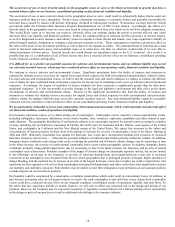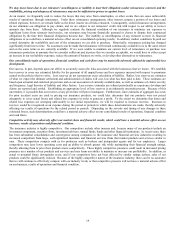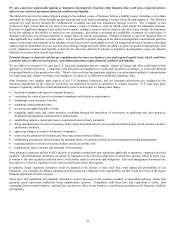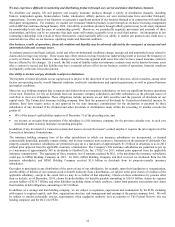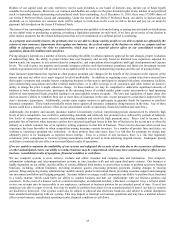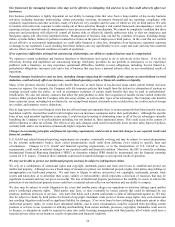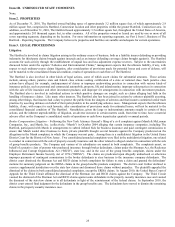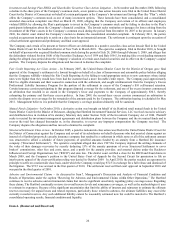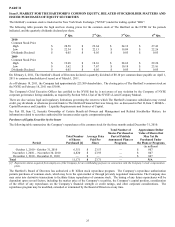The Hartford 2010 Annual Report Download - page 17
Download and view the complete annual report
Please find page 17 of the 2010 The Hartford annual report below. You can navigate through the pages in the report by either clicking on the pages listed below, or by using the keyword search tool below to find specific information within the annual report. 17
Losses due to nonperformance or defaults by others, including issuers of investment securities (which include structured securities
such as commercial mortgage backed securities and residential mortgage backed securities or other high yielding bonds) mortgage
loans or reinsurance and derivative instrument counterparties, could have a material adverse effect on the value of our investments,
results of operations, financial condition and cash flows.
Issuers or borrowers whose securities or loans we hold, customers, trading counterparties, counterparties under swaps and other
derivative contracts, reinsurers, clearing agents, exchanges, clearing houses and other financial intermediaries and guarantors may
default on their obligations to us due to bankruptcy, insolvency, lack of liquidity, adverse economic conditions, operational failure,
fraud, government intervention or other reasons. Such defaults could have a material adverse effect on our results of operations,
financial condition and cash flows. Additionally, the underlying assets supporting our structured securities or loans may deteriorate
causing these securities or loans to incur losses.
Our investment portfolio includes securities backed by real estate assets the value of which have been adversely impacted by the recent
recessionary period and the associated property value declines, resulting in a reduction in expected future cash flow for certain
securities. Further property value declines and loss rates that exceed our current estimates, as outlined in Part II, Item 7, MD&A –
Investment Credit Risk – Other-Than-Temporary Impairments, could have a material adverse effect on our results of operations,
financial condition and cash flows.
The Company is not exposed to any credit concentration risk of a single issuer greater than 10% of the Company’ s stockholders’ equity
other than U.S. government and U.S. government agencies backed by the full faith and credit of the U.S. government. However, if
issuers of securities or loans we hold are acquired, merge or otherwise consolidate with other issuers of securities or loans held by the
Company, the Company’ s credit concentration risk could increase above the 10% threshold, for a period of time, until the Company is
able to sell securities to get back in compliance with the established investment credit policies.
If assumptions used in estimating future gross profits differ from actual experience, we may be required to accelerate the
amortization of DAC and increase reserves for guaranteed minimum death and income benefits, which could have a material
adverse effect on our results of operations and financial condition.
The Company defers acquisition costs associated with the sales of its universal and variable life and variable annuity products. These
costs are amortized over the expected life of the contracts. The remaining deferred but not yet amortized cost is referred to as the
Deferred Acquisition Cost (“DAC”) asset. We amortize these costs in proportion to the present value of estimated gross profits
(“EGPs”). The Company evaluates the EGPs compared to the DAC asset to determine if an impairment exists. The Company also
establishes reserves for GMDB and GMIB using components of EGPs. The projection of estimated gross profits or components of
estimated gross profits requires the use of certain assumptions, principally related to separate account fund returns in excess of amounts
credited to policyholders, surrender and lapse rates, interest margin (including impairments), mortality, benefit utilization, annuitization
and hedging costs. Of these factors, we anticipate that changes in investment returns are most likely to impact the rate of amortization
of such costs. However, other factors such as those the Company might employ to reduce risk, such as the cost of hedging or other risk
mitigating techniques, could also significantly reduce estimates of future gross profits. Estimating future gross profits is a complex
process requiring considerable judgment and the forecasting of events well into the future. If our assumptions regarding policyholder
behavior, including lapse rates, benefit utilization, surrenders, and annuitization, hedging costs or costs to employ other risk mitigating
techniques prove to be inaccurate or if significant or sustained equity market declines occur, we could be required to accelerate the
amortization of DAC related to variable annuity and variable universal life contracts, and increase reserves for GMDB and GMIB which
would result in a charge to net income. Such adjustments could have a material adverse effect on our results of operations and financial
condition.
If our businesses do not perform well, we may be required to recognize an impairment of our goodwill or to establish a valuation
allowance against the deferred income tax asset, which could have a material adverse effect on our results of operations and
financial condition.
Goodwill represents the excess of the amounts we paid to acquire subsidiaries and other businesses over the fair value of their net assets
at the date of acquisition. We test goodwill at least annually for impairment. Impairment testing is performed based upon estimates of
the fair value of the “reporting unit” to which the goodwill relates. The reporting unit is the operating segment or a business one level
below that operating segment if discrete financial information is prepared and regularly reviewed by management at that level. The fair
value of the reporting unit is impacted by the performance of the business and could be adversely impacted by any efforts made by the
Company to limit risk. If it is determined that the goodwill has been impaired, the Company must write down the goodwill by the
amount of the impairment, with a corresponding charge to net income. These write downs could have a material adverse effect on our
results of operations or financial condition.
Deferred income tax represents the tax effect of the differences between the book and tax basis of assets and liabilities. Deferred tax
assets are assessed periodically by management to determine if they are realizable. Factors in management’ s determination include the
performance of the business including the ability to generate capital gains, to offset previously recognized capital losses, from a variety
of sources and tax planning strategies. If based on available information, it is more likely than not that we are unable to recognize a full
tax benefit on realized capital losses, then a valuation allowance will be established with a corresponding charge to net income. Charges
to increase our valuation allowance could have a material adverse effect on our results of operations and financial condition.


